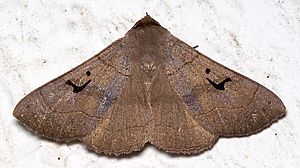Brown panopoda facts for kids
Quick facts for kids Brown panopoda |
|
|---|---|
 |
|
| Scientific classification | |
| Synonyms | |
|
The brown panopoda (scientific name: Panopoda carneicosta) is a type of moth. It belongs to a large family of moths called Erebidae. Scientists first officially described this moth in 1852. A French scientist named Achille Guenée was the first to do so.
Contents
Meet the Brown Panopoda Moth
What is the Brown Panopoda?
The brown panopoda is a fascinating moth. It gets its common name from its brownish color. Like all moths, it has a special life cycle. It starts as an egg, then becomes a larva (caterpillar), then a pupa, and finally an adult moth.
Where Does This Moth Live?
You can find the brown panopoda moth across a wide area of North America. It lives in places like Ontario and Quebec in Canada. In the United States, it ranges from Maine in the northeast, all the way south to Florida. It also lives west to Texas and north to Wisconsin and Minnesota.
How Big Are They and When Do They Fly?
The brown panopoda moth has a wingspan of about 38 to 46 millimeters. That's roughly the size of a large paperclip to a little over an inch and a half. These moths are usually seen flying during the warmer months.
They are most active in June and July. However, some have been spotted as early as April and as late as September. In the northern parts of their range, they usually have one generation per year. This means they complete their full life cycle once a year. In the warmer southern areas, they might have two generations in a single year.
What Do Brown Panopoda Caterpillars Eat?
The young brown panopoda moths, which are caterpillars, enjoy eating leaves. They feed on the leaves of several different trees. Their favorite foods include basswood, oak, hickory, and willow trees. These plants provide all the energy they need to grow.

